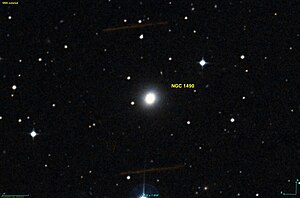NGC 1490
| Galaxy NGC 1490 |
|
|---|---|

|
|
| AladinLite | |
| Constellation | network |
|
Position equinox : J2000.0 , epoch : J2000.0 |
|
| Right ascension | 03 h 53 m 34.2 s |
| declination | -66 ° 01 ′ 05 ″ |
| Appearance | |
| Morphological type | E. |
| Brightness (visual) | 12.4 mag |
| Brightness (B-band) | 13.4 mag |
| Angular expansion | 1.3 ′ × 1.1 ′ |
| Position angle | 142 ° |
| Surface brightness | 12.9 mag / arcmin² |
| Physical data | |
| Redshift | 0.017897 ± 0.000026 |
| Radial velocity | (5365 ± 8) km / s |
|
Stroke distance v rad / H 0 |
(232 ± 16) x 10 6 ly (71.1 ± 5.0) Mpc |
| history | |
| discovery | John Herschel |
| Discovery date | November 2, 1834 |
| Catalog names | |
| NGC 1490 • PGC 14040 • ESO 083-011 • 2MASX J03533420-6601052 • SGC 035309-6609.8 • GC 792 • h 2599 • LDCE 0274 NED001 | |
NGC 1490 is an elliptical galaxy from the Hubble type E1 in the constellation network at the southern sky . It is an estimated 232 million light years from the Milky Way .
The object was discovered by John Herschel on November 2, 1834 .
